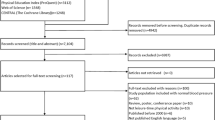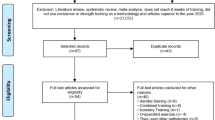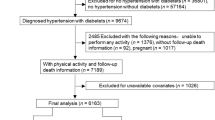Abstract
Hypertension affects more than 4 billion people worldwide and is a major risk factor for cardiovascular disease. Improving physical activity is an effective way to manage hypertension, and there has been a lot of interest in the use of wearable devices for promoting physical activity, which have become increasingly popular in recent years, but in many countries, improvements in physical activity levels remain inadequate. This systematic review and meta-analysis investigated whether interventions using wearable devices have a beneficial effect on blood pressure in adults. Following PRISMA 2020 guidelines and registered with PROSPERO (CRD42023442506), we searched PubMed, MEDLINE, Cochrane Library, and IchuShi-Web, identifying 21 randomized controlled trials including participants with hypertension, type 2 diabetes, or overweight/obesity. Interventions ranged from 12 to 48 weeks using pedometers, activity trackers, and smartwatches. Random-effects meta-analysis showed these interventions did not produce statistically significant improvements in systolic or diastolic blood pressure at any intervention duration (12, 24, or 48 weeks). Similarly, no statistically significant improvements were found in secondary outcomes (body weight, fasting blood glucose, and Hemoglobin A1c). Heterogeneity varied from low to high depending on outcome and intervention period. These findings indicate that evidence of direct intervention using wearable devices for promoting physical activity alone is currently insufficient to establish clinically meaningful improvements in blood pressure and related metabolic parameters. Future research may need to integrate wearable technology into comprehensive care models that combine targeted feedback and education with behavioral support strategies, rather than direct intervention through monitoring alone.

This is a preview of subscription content, access via your institution
Access options
Subscribe to this journal
Receive 12 print issues and online access
$259.00 per year
only $21.58 per issue
Buy this article
- Purchase on SpringerLink
- Instant access to full article PDF
Prices may be subject to local taxes which are calculated during checkout






Similar content being viewed by others
References
World Health Organization. Hypertension. 2021. https://www.who.int/news-room/fact-sheets/detail/hypertension. Accessed 28 Sep 2023.
Mills KT, Stefanescu A, He J. The global epidemiology of hypertension. Nat Rev Nephrol. 2020;16:223–37.
Umemura S, Arima H, Arima S, Asayama K, Dohi Y, Hirooka Y, et al. The Japanese Society of Hypertension Guidelines for the Management of Hypertension (JSH 2019). Hypertens Res. 2019;42:1235–481.
Waki T, Miura K, Tanaka-Mizuno S, Ohya Y, Node K, Itoh H, et al. Prevalence of hypertensive diseases and treated hypertensive patients in Japan: A nationwide administrative claims database study. Hypertens Res. 2022;45:1123–33.
Chodzko-Zajko WJ, Proctor DN, Fiatarone Singh MA, Minson CT, Nigg CR, Salem GJ, et al. American College of Sports Medicine position stand. Exercise and physical activity for older adults. Med Sci Sports Exerc. 2009;41:1510–30.
Colberg SR, Sigal RJ, Yardley JE, Riddell MC, Dunstan DW, Dempsey PC, et al. Physical activity/exercise and diabetes: a position statement of the American Diabetes Association. Diabetes Care. 2016;39:2065–79.
Statistics Canada. Physical activity, self-reported, adult, by age group. 2021. https://www150.statcan.gc.ca/t1/tbl1/en/tv.action?pid=1310009613. Accessed 28 Sep 2023.
Brickwood KJ, Watson G, O’Brien J, Williams AD. Consumer-based wearable activity trackers increase physical activity participation: systematic review and meta-analysis. JMIR Mhealth Uhealth. 2019;7:e11819.
Romeo A, Edney S, Plotnikoff R, Curtis R, Ryan J, Sanders I, et al. Can smartphone apps increase physical activity? Systematic review and meta-analysis. J Med Internet Res. 2019;21:e12053.
Huhn S, Axt M, Gunga HC, Maggioni MA, Munga S, Obor D, et al. The impact of wearable technologies in health research: scoping review. JMIR Mhealth Uhealth. 2022;10:e34384.
Lyons EJ, Lewis ZH, Mayrsohn BG, Rowland JL. Behavior change techniques implemented in electronic lifestyle activity monitors: a systematic content analysis. J Med Internet Res. 2014;16:e192.
Patel MS, Asch DA, Volpp KG. Wearable devices as facilitators, not drivers, of health behavior change. JAMA. 2015;313:459–60.
Franssen WMA, Franssen GHLM, Spaas J, Solmi F, Eijnde BO. Can consumer wearable activity tracker-based interventions improve physical activity and cardiometabolic health in patients with chronic diseases? A systematic review and meta-analysis of randomised controlled trials. Int J Behav Nutr Phys Act. 2020;17:57.
Gu Y, Bao X, Wang Y, Meng G, Wu H, Zhang Q, et al. Effects of self-monitoring devices on blood pressure in older adults with hypertension and diabetes: a randomised controlled trial. J Epidemiol Community Health. 2020;74:137–43.
Stockwell S, Schofield P, Fisher A, Firth J, Jackson SE, Stubbs B, et al. Digital behavior change interventions to promote physical activity and/or reduce sedentary behavior in older adults: a systematic review and meta-analysis. Exp Gerontol. 2019;120:68–87.
Page MJ, McKenzie JE, Bossuyt PM, Boutron I, Hoffmann TC, Mulrow CD, et al. The PRISMA 2020 statement: an updated guideline for reporting systematic reviews. BMJ. 2021;372:n71.
Minds Manual Developing Committee, editor. Minds manual for guideline development 2020 ver. 3.0. Tokyo: Japan Council for Quality Health Care; 2021.
Engel L, Lindner H. Impact of using a pedometer on time spent walking in older adults with type 2 diabetes. Diabetes Educ. 2006;32:98–107.
Bjørgaas MR, Vik JT, Stølen T, Lydersen S, Grill V. Regular use of pedometer does not enhance beneficial outcomes in a physical activity intervention study in type 2 diabetes mellitus. Metabolism. 2008;57:605–11.
Bell GJ, Harber V, Murray T, Courneya KS, Rodgers W. A comparison of fitness training to a pedometer-based walking program matched for total energy cost. J Phys Act Health. 2010;7:203–13.
Kolt GS, Schofield GM, Kerse N, Garrett N, Ashton T, Patel A. Healthy Steps trial: pedometer-based advice and physical activity for low-active older adults. Ann Fam Med. 2012;10:206–12.
Shrestha M, Combest T, Fonda SJ, Alfonso A, Guerrero A. Effect of an accelerometer on body weight and fitness in overweight and obese active duty soldiers. Mil Med. 2013;178:82–7.
Van Dyck D, De Greef K, Deforche B, Ruige J, Bouckaert J, Tudor-Locke CE, et al. The relationship between changes in steps/day and health outcomes after a pedometer-based physical activity intervention with telephone support in type 2 diabetes patients. Health Educ Res. 2013;28:539–45.
Petrella RJ, Stuckey MI, Shapiro S, Gill DP. Mobile health, exercise and metabolic risk: a randomized controlled trial. BMC Public Health. 2014;14:1082.
Dawes D, Ashe M, Campbell K, Cave D, Elley CR, Kaczorowski J, et al. Preventing diabetes in primary care: a feasibility cluster randomized trial. Can J Diabetes. 2015;39:111–6.
Finkelstein EA, Haaland BA, Bilger M, Sahasranaman A, Sloan RA, Nang EEK, et al. Effectiveness of activity trackers with and without incentives to increase physical activity (TRIPPA): a randomised controlled trial. Lancet Diabetes Endocrinol. 2016;4:983–95.
Frias J, Virdi N, Raja P, Kim Y, Savage G, Osterberg L. Effectiveness of digital medicines to improve clinical outcomes in patients with uncontrolled hypertension and type 2 diabetes: prospective, open-label, cluster-randomized pilot clinical trial. J Med Internet Res. 2017;19:e246.
Kempf K, Röhling M, Stichert M, Fischer G, Boschem E, Könner J, et al. Telemedical coaching improves long-term weight loss in overweight persons: a randomized controlled trial. Int J Telemed Appl. 2018;2018:7530602.
Maxwell-Smith C, Hince D, Cohen PA, Bulsara MK, Boyle T, Platell C, et al. A randomized controlled trial of WATAAP to promote physical activity in colorectal and endometrial cancer survivors. Psychooncology. 2019;28:1420–9.
Romero Z, Kimbrough S. The impact of moderate physical activity on weight and blood pressure in an elderly Mexican-American female population. TAHPERD J. 2019;87:8–12.
Zha P, Qureshi R, Porter S, Chao YY, Pacquiao D, Chase S, et al. Utilizing a mobile health intervention to manage hypertension in an underserved community. West J Nurs Res. 2020;42:201–9.
Brickwood KJ, Ahuja KDK, Watson G, O’Brien JA, Williams AD. Effects of activity tracker use with health professional support or telephone counseling on maintenance of physical activity and health outcomes in older adults: randomized controlled trial. JMIR Mhealth Uhealth. 2021;9:e18686.
Leskinen T, Suorsa K, Heinonen IH, Löyttyniemi E, Pentti J, Vahtera J, et al. The effect of commercial activity tracker based physical activity intervention on body composition and cardiometabolic health among recent retirees. Front Aging. 2021;2:757080.
Pelletier C, Gagnon MP, Alméras N, Després JP, Poirier P, Tremblay A, et al. Using an activity tracker to increase motivation for physical activity in patients with type 2 diabetes in primary care: a randomized pilot trial. Mhealth. 2021;7:59.
Vaz CL, Carnes N, Pousti B, Zhao H, Williams KJ. A randomized controlled trial of an innovative, user-friendly, interactive smartphone app-based lifestyle intervention for weight loss. Obes Sci Pract. 2021;7:555–68.
Gómez-Sánchez L, Gómez-Sánchez M, Lugones-Sánchez C, Rodríguez-Sánchez E, Tamayo-Morales O, Gonzalez-Sánchez S, et al. Long-term effectiveness of a smartphone app and a smart band on arterial stiffness and central hemodynamic parameters in a population with overweight and obesity (Evident 3 study): randomised controlled trial. Nutrients. 2022;14:4758.
Zhang Y, Tao Y, Zhong Y, Thompson j, Rahmani j, Bhagavathula AS, et al. Feedback based on health advice via tracing bracelet and smartphone in the management of blood pressure among hypertensive patients: A community-based RCT trial in Chongqing, China. Medicine (Baltimore). 2022;101:e29450.
Acknowledgements
This study is supported by the Japan Agency for Medical Research and Development (22rea522002h000122rea522002h0001, 1 Oct 2022).
Author information
Authors and Affiliations
Contributions
HA conceived and supervised the study. MK, NH, KN, and KO conducted the creation of PICO, data screening, data extraction, and risk of bias evaluation. MK conducted analyses and wrote a first draft. All authors critically reviewed the manuscript and provided valuable suggestions. All authors have accepted responsibility for the entire content of this manuscript and approved its submission.
Corresponding author
Ethics declarations
Conflict of interest
The authors declare no competing interests.
Additional information
Publisher’s note Springer Nature remains neutral with regard to jurisdictional claims in published maps and institutional affiliations.
Supplementary information
Rights and permissions
Springer Nature or its licensor (e.g. a society or other partner) holds exclusive rights to this article under a publishing agreement with the author(s) or other rightsholder(s); author self-archiving of the accepted manuscript version of this article is solely governed by the terms of such publishing agreement and applicable law.
About this article
Cite this article
Koyama, M., Himuro, N., Nakata, K. et al. Effects of physical activity-promoting wearable devices on blood pressure in adults: a systematic review and meta-analysis. Hypertens Res 48, 2677–2687 (2025). https://doi.org/10.1038/s41440-025-02260-6
Received:
Revised:
Accepted:
Published:
Issue date:
DOI: https://doi.org/10.1038/s41440-025-02260-6
Keywords
This article is cited by
-
Wearable devices for physical activity: limited impact on blood pressure, unlimited potential for health innovation
Hypertension Research (2025)



